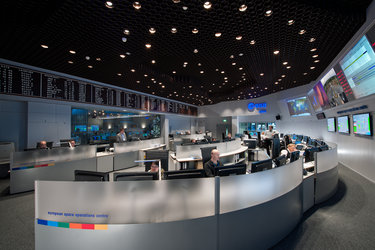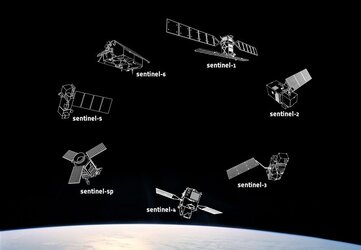Ian Shurmer: Spacecraft Operations Manager
Ian Shurmer is the Spacecraft Operations Manager (SOM) for the Sentinel-1 mission at ESOC, ESA's Space Operations Centre, Darmstadt, Germany, where he directly oversees a team of seven engineers.

Ian Shurmer is from Dartford, UK, and studied Aeronautics and Astronautics at Southampton University, graduating in 1987. He has over 27 years’ experience in spacecraft operations at several European industrial firms and, since 2001, at ESA supporting Earth observation missions Cryosat, GOCE, Aeolus and the Sentinels. He has directly supported eight satellite launches to date, the most recent being Cryosat-2 as deputy SOM. Ian joined ESA as a staff member in 2008, assigned to work as a Sentinels Operations Engineer, and he was appointed Sentinel-1 Spacecraft Operations Manager in 2012.
ESA: This is the first time you’ve served as Spacecraft Operations Manager. How’s it going?
Ian Shurmer
It’s going great. For me, it’s the ‘dream’ systems engineering job. After almost three decades working in space, it’s now an opportunity to work in the most challenging and demanding role in the field of spacecraft operations. In short, I love it.
ESA: What is the most challenging aspect of your job?
Ian Shurmer
I’m very familiar with the technologies, the processes and the systems, so those are not too difficult. Rather, it’s the schedule specific to the Sentinel-1A preparations that has been and continues to be a challenge. We’re not cutting corners or taking any unnecessary risks, but we have had to work very hard to fit everything into the time available, particularly for the training and launch campaign.
This has partly been caused by the recent intense pace of operations at ESOC in general; our launch control facilities were fully booked last autumn for the Swarm and Gaia launches, which took place in November and December 2013, respectively. So we couldn’t start our simulation and training campaign until January 2014. The simulations campaign has been compressed and intense, but is on schedule.
ESA: What tasks and responsibilities in your role as SOM are new to you?
Ian Shurmer
In my previous jobs as operations engineer for various missions, I tended to focus on specific subsystems of the satellite, in my case the Data Handling subsystem. As SOM, however, you have to take the ‘systems’ perspective and become familiar with the overall mission and all of the satellite and ground systems. You also have to become very familiar with the payload, which for Sentinel-1A means understanding the planning and operations for the Synthetic Aperture Radar (SAR).
Being SOM also involves managing the activities of the Sentinel-1 Flight Control Team (FCT), coordinating with the other Sentinel teams at ESOC (Sentinel-2 and -3 – Ed.) and interfacing with the Centre’s experts in Flight Dynamics, Ground Stations, Mission Control Systems and Simulators.
Finally, the SOM also has to devote time to managing interfaces external to ESOC, particularly with the Sentinel-1 Project Team at ESTEC, the Payload Data Ground Segment (PDGS) at ESRIN and, of course, the satellite prime contractor.
So all of these tasks were new for me as SOM, but it’s all been very interesting and challenging.
ESA: What have been some of the highlights of getting ready for launch?
Ian Shurmer
I joined Sentinel in 2008, when the level of activity was rather calm – for the first couple years we were working to define the requirements and operating procedures and to develop the mission control system and the spacecraft simulator. We also worked routinely with the satellite manufacturer, Thales Alenia Italy, to review the design and verify progress.
Since 2012, when I was appointed SOM, it’s become more interesting. Between November 2012 and February 2014 we conducted a series of SVTs – System Validation Tests. In these, the actual satellite was connected via remote telecom link from the factory in Rome to our control system here at ESOC. We could validate the sending of commands to the satellite, receive ‘real’ telemetry, and validate our operations procedures. These are the highlights of the preparation phase for the FCT, allowing the team to become familiar with the operation of the actual satellite rather than just a simulator.
ESA: What sort of training is the team undergoing?
Ian Shurmer
We began our pre-simulation training the week before Christmas 2013, but, as I mentioned, we couldn’t get into the Main Control Room at ESOC until after Gaia’s L2 orbit insertion in January. Since then, we’ve been conducting numerous simulation (‘sim’) training sessions – by the time we’re finished, just before launch, we’ll have completed 25 or 30 sessions.
Of these about 40 percent will have been ‘nominal ’ – meaning that the Sim Officers didn’t inject any faults – and about 60 percent will have been ‘contingency’ sims. This training ensures that the Mission Control Team can work together to handle any possible unexpected problems.
Recently, in one training session simulating lift off and first acquisition of signal from the satellite, there was no telemetry being received from the satellite – the ground station was receiving nothing. That required us to recognise the problem, identify what might be causing it and immediately implement a specific recovery procedure. Later, the Mission Control System – the software on ground that enables us to control the satellite – failed, and later we also had a failure at the ground tracking station. It’s all rather intense, extremely valuable, but also very enjoyable.
ESA: What can you recommend to anyone aiming for a career in satellite operations?
Ian Shurmer
As well as getting a relevant degree, I would recommend first getting a job with one of the major prime satellite contractors to get general space industry experience. These companies are great places to learn the trade and will introduce you to all aspects of the satellite industry, not just satellite operations.
Editor's note:
This is one in a series of interviews with a few of the key people that are involved in the Sentinel-1 mission and Copernicus programme. Please check back as the list will be added to over the coming weeks.








